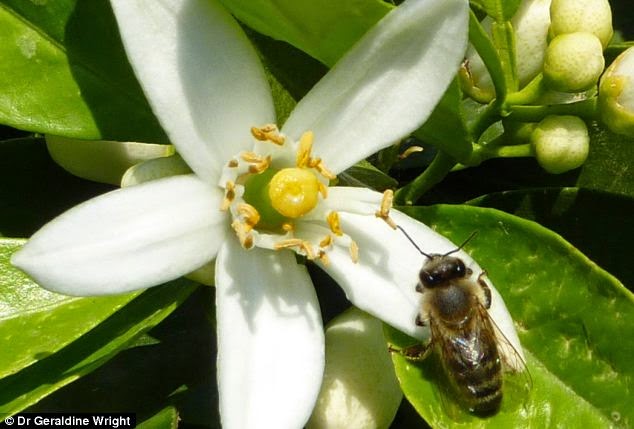Pollinators get a buzz off caffeine, too
Most plants can reproduce asexually – that is, new plant life is created without the need for female and male sex cells to combine. However, amongst plants there is a variety of ways in which they can reproduce sexually. Sexual reproduction confers certain advantages to organisms: for example, by the remixing of sexual cells, more variation is maintained within a population and there are more likely to be some organisms able to withstand environmental changes. Animal-mediated pollination is a common way by which plants distribute their sex cells to other individuals in a population. Plant have evolved a wide variety of mechanisms to increase the likelihood of pollination, including conspicuous flowers, enticing scents, and sweet nectar rewards. Coffea and Citrus are plant genera which both exhibit attractive flowers and produce more fruit and seeds when pollinated by bees (Ricketts, 2004), which they reward with nectar. However, the nectar of species in these genera contain another, more harmful substance.
 |
| © Geraldine Wright |
Species of Coffea and Citrus contain caffeine in their nectar, as well as sugars. Amongst our own species, more caffeine is consumed than any other psychoactive drug (Nehlig, 1999). Despite the stimulating effect this substance induces in people, in nature caffeine is nor usually a treat but a threat: high doses generally have a defensive purpose for plants and produce a negative effect in animals. Why, then, would a pollinator reward contain caffeine – surely it would be disadvantageous to the plant to cause serious harm to its pollinators and would thus be selected against? Wright et al. (2013) proposed to answer this question.
 |
| © 7bigspoons.com |
As is the way in science, these interesting results prompted more questions. Wright et al. (2013) wanted to determine by what mechanisms caffeine affects the insects’ memory capabilities. The authors imaged the electrical activity in intact bees’ brains, specifically looking at the cells associated with learning and memory. They found that, in a similar way to how the substance acts in our own brain cells, caffeine excites nerve pulses in these cells.
Thus, despite the damaging consequences of high doses of caffeine, Wright et al. (2013) demonstrate how producing mildly caffeinated nectar confers a selective advantage to plants by enhancing the memory of pollinators. Additionally, they have shown how the neuronal responses to caffeine in bees are not dissimilar to those in – the very different – human brain.
Cited literature:
Nehlig, A. (1999) Are we dependent upon coffee and caffeine? A review on human and animal data. Neuroscience & Biobehavioral Reviews, 23(4), 563-576.
Ricketts, T. H. (2004) Tropical Forest Fragments Enhance Pollinator Activity in Nearby Coffee Crops. Conservation Biology, 18(5), 1262-1271.
Wright, G. A., Baker, D. D., Palmer, M. J., Stabler, D., Mustard, J. A., Power, E. F., Borland, A. M. & Stevenson, P. C. (2013) Caffeine in Floral Nectar Enhances a Pollinator's Memory of Reward. Science, 339(6124),1202-1204.



Comments
Post a Comment